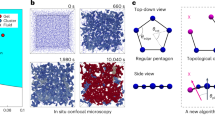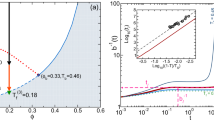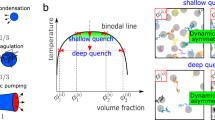Abstract
The mechanism by which a liquid may become arrested, forming a glass or gel, is a long-standing problem of materials science. In particular, long-lived (energetically) locally favoured structures (LFSs), the geometry of which may prevent the system relaxing to its equilibrium state, have long been thought to play a key role in dynamical arrest. Here, we propose a definition of LFSs which we identify with a novel topological method and directly measure with experiments on a colloidal liquid–gel transition. The population of LFSs is a strong function of (effective) temperature in the ergodic liquid phase, rising sharply approaching dynamical arrest, and indeed forms a percolating network that becomes the ‘arms’ of the gel. Owing to the LFSs, the gel is unable to reach equilibrium, crystal–gas coexistence. Our results provide direct experimental observation of a link between local structure and dynamical arrest, and open a new perspective on a wide range of metastable materials.
This is a preview of subscription content, access via your institution
Access options
Subscribe to this journal
Receive 12 print issues and online access
$259.00 per year
only $21.58 per issue
Buy this article
- Purchase on Springer Link
- Instant access to full article PDF
Prices may be subject to local taxes which are calculated during checkout




Similar content being viewed by others
References
Trappe, V., Prasad, V., Cipelletti, P., L., Segre, N. & Weitz, D. A. Jamming phase diagram for attractive particles. Nature 411, 772–775 (2001).
Sciortino, F. & Tartaglia, P. Glassy colloidal systems. Adv. Phys. 54, 471–524 (2005).
Poon, W. C. K. The physics of a model colloid-polymer mixture. J. Phys. Condens. Matter. 14, R859–R880 (2002).
Manley, S. et al. Glasslike arrest in spinodal decomposition as a route to colloidal gelation. Phys. Rev. Lett. 95, 238302 (2005).
Zaccarelli, E. Colloidal gels: Equilibrium and non-equilibrium routes. J. Phys. Condens. Matter 19, 323101 (2007).
Frank, F. C. Supercooling of liquids. Proc. R. Soc. Lond. A 215, 43–46 (1952).
Tanaka, H. Two-order-parameter description of liquids. 1. A general model of glass transition covering its strong to fragile limit. J. Chem. Phys. 111, 3163–3174 (1999).
Ediger, M. Spatially heterogeneous dynamics in supercooled liquids. Annu. Rev. Phys. Chem. 51, 99–128 (2000).
Widmer-Cooper, A. & Harrowell, P. On the relationship between structure and dynamics in a supercooled liquid. J. Phys. Condens. Matter 17, S4025–S4034 (2005).
Widmer-Cooper, A. & Harrowell, P. Free volume cannot explain the spatial heterogeneity of Debye–Waller factors in a glass-forming binary alloy. J. Non-Cryst. Solids 352, 5098–5102 (2006).
Tanaka, H. Viscoelastic phase separation. J. Phys. Condens. Matter 12, R207–R264 (2000).
Wales, D. J. Energy Landscapes: Applications to Clusters, Biomolecules and Glasses (Cambridge Univ. Press, Cambridge, 2004).
Debenedetti, P. G. & Stillinger, F. H. Supercooled liquids and the glass transition. Nature 410, 259–267 (2001).
Mossa, S. & Tarjus, G. Locally preferred structure in simple atomic liquids. J. Chem. Phys. 119, 8069–8074 (2003).
Steinhardt, P. J., Nelson, D. R. & Ronchetti, M. Bond-orientational order in liquids and gases. Phys. Rev. B 28, 784–805 (1983).
Jonsson, H. & Andersen, H. Icosahedral ordering in the Lennard-Jones liquid and glass. Phys. Rev. Lett. 60, 2295–2298 (1988).
Reichert, H. et al. Observation of five-fold local symmetry in liquid lead. Nature 408, 839–841 (2000).
Di Cicco, A., Trapananti, A., Faggioni, S. & Filipponi, A. Is there icosahedral ordering in liquid and undercooled metals? Phys. Rev. Lett. 91, 135505 (2003).
Schenk, T., Holland-Moritz, D., Simonet, V., Bellissent, R. & Herlach, D. M. Icosahedral short-range order in deeply undercooled metallic melts. Phys. Rev. Lett. 89, 075507 (2002).
Pusey, P. N. in Liquids, Freezing and the Glass Transition (eds Hansen, J. P., Levesque, D. & Zinn-Justin, J.) (North-Holland, Amsterdam, 1991).
van Blaaderen, A. & Wiltzius, P. Real-space structure of colloidal hard-sphere glasses. Science 270, 1177–1179 (1995).
Campbell, A. I., Anderson, V. J., van Duijneveldt, J. S. & Bartlett, P. Dynamical arrest in attractive colloids: The effect of long-range repulsion. Phys. Rev. Lett. 94, 208301 (2005).
Gasser, U., Schofield, A. & Weitz, D. Local order in a supercooled colloidal fluid observed by confocal microscopy. J. Phys. Condens. Matter 15, S375–S380 (2003).
Doye, J. P. K., Wales, D. J. & Berry, R. S. The effect of the range of the potential on the structures of clusters. J. Chem. Phys. 103, 4234–4249 (1995).
Asakura, S. & Oosawa, F. On interaction between 2 bodies immersed in a solution of macromolecules. J. Chem. Phys. 22, 1255–1256 (1954).
Royall, C. P., Louis, A. & Tanaka, H. Measuring colloidal interactions with confocal microscopy. J. Chem. Phys. 127, 044507 (2007).
Pham, K. N. et al. Multiple glassy states in a simple model system. Science 296, 104–106 (2002).
Williams, S. R. Topological classification of clusters in condensed phases. Preprint at <http://arxiv.org/abs/0705.0203> (2007).
Charbonneau, P. & Reichman, D. Systematic characteristation of thermodynamic and dynamical phase behaviour in systems with short-ranged attraction. Phys. Rev. E 75, 011507 (2007).
Manoharan, V. N., Elesser, M. T. & Pine, D. J. Dense packing and symmetry in small clusters of microspheres. Science 301, 483–487 (2003).
Puertas, A. M., Fuchs, M. & Cates, M. E. Dynamical heterogeneities close to a colloidal gel. J. Chem. Phys. 121, 2813–2822 (2004).
Weeks, E., Crocker, J., Levitt, A., Schofield, A. & Weitz, D. Three-dimensional direct imaging of structural relaxation near the colloidal glass transition. Science 287, 627–631 (2001).
Kroy, K., Cates, M. & Poon, W. Cluster mode-coupling approach to weak gelation in attractive colloids. Phys. Rev. Lett. 92, 148302 (2004).
Acknowledgements
The authors are grateful to A. van Blaaderen and D. Derks for particle synthesis help and gifts. We wish to thank P. Bartlett, D. Derks, D. Head and R. Jack for critical reading of the manuscript, and T. Ichikawa for kind instrumentation support. This work was partially supported by a grant-in-aid from the Ministry of Education, Culture, Sports, Science and Technology, Japan. C.P.R. is grateful to the Royal Society for financial support.
Author information
Authors and Affiliations
Contributions
C.P.R., S.R.W. and H.T. conceived the project and wrote the manuscript, C.P.R. carried out the experiments, simulation and analysis, S.R.W. wrote the TCC code and T.O. wrote the W6 analysis code.
Corresponding authors
Supplementary information
Supplementary Information
Supplementary Figures Fig S1–S6 and Equation S2 (PDF 1450 kb)
Supplementary Information
Supplementary Video Legends (PDF 10 kb)
Rights and permissions
About this article
Cite this article
Patrick Royall, C., Williams, S., Ohtsuka, T. et al. Direct observation of a local structural mechanism for dynamic arrest. Nature Mater 7, 556–561 (2008). https://doi.org/10.1038/nmat2219
Received:
Accepted:
Published:
Issue Date:
DOI: https://doi.org/10.1038/nmat2219
This article is cited by
-
Hierarchical amorphous ordering in colloidal gelation
Nature Physics (2023)
-
Ultrastable glasses: new perspectives for an old problem
La Rivista del Nuovo Cimento (2022)
-
Total synthesis of colloidal matter
Nature Reviews Materials (2021)
-
Autonomously revealing hidden local structures in supercooled liquids
Nature Communications (2020)
-
Modulating electrolyte structure for ultralow temperature aqueous zinc batteries
Nature Communications (2020)



